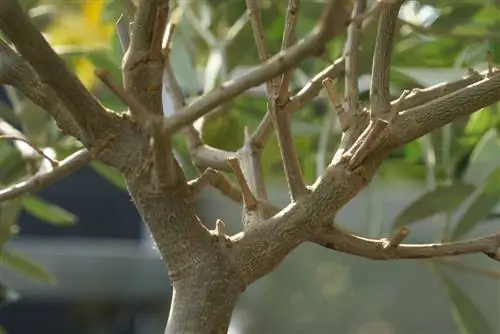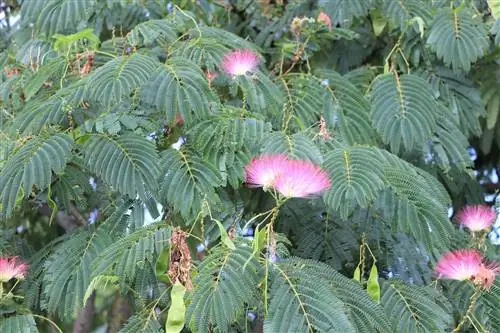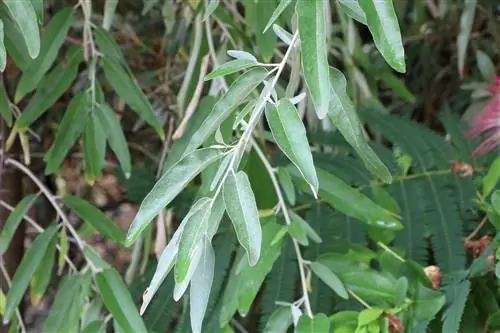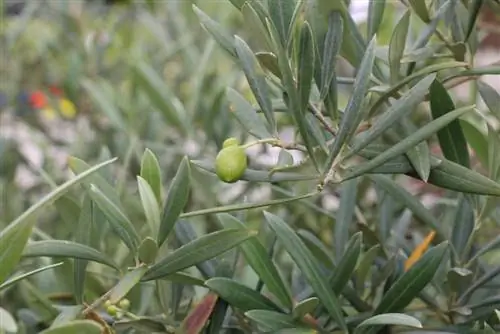- Author admin [email protected].
- Public 2023-12-17 03:39.
- Last modified 2025-01-24 12:45.
The olive tree (Olea europaea) is a medium-sized, gnarled tree from the olive family. The evergreen tree with the small, leathery leaves is not native to us. It is actually too cool for the plant in Germany, but it is still one of the popular plants here that exudes a touch of Mediterranean flair. However, the real olive tree is better kept in a pot in a winter garden than in the garden or on the terrace or balcony in summer.
Location
Olea europaea is one of the sun children that is only native to warm winter regions. The brighter and warmer the tree is, the better it will grow and thrive. Since this is not necessarily possible outdoors in Germany, it is usually cultivated as a pot plant.
- full sun in summer
- as warm as possible
- tolerates heat
- does not tolerate drafts
Cultivation in a bucket
An olive tree prefers mild temperatures all year round and cannot tolerate severe frosts. Since there is a certain risk that the plant will not survive the cold season in the open field, there are actually certain restrictions on its cultivation. In cold regions, living outdoors all year round is impossible. The advantage of planting in a bucket is therefore obvious: the olive tree can easily be transported to a frost-free place.
However, if you want to grow the tree as a houseplant, you should know that the olive tree will not find good conditions in the apartment in the long term. That's why the plant must be planted outdoors in the warm season, be it on a balcony or terrace or in the garden soil together with a pot.
- Dwarf varieties are particularly suitable
- Pot size should roughly correspond to the crown size
Substrate
When planting or repotting an olive tree, you should only use very high-quality substrates. Good potted plant soils are characterized by coarse-grained components such as gravel, lava granules or expanded clay. They are loose and allow both water and air to pass through very well. To better store water and nutrients, a proportion of humus is also necessary, but this should not be too high when cultivating olive trees.
- high mineral content (sand, gravel, expanded clay, etc.)
- low humus content
- Cactus soil mixed with clay
- Substrates for Mediterranean plants
- sandy-loamy soil mixture
- Citrus plant soil
Outdoor stay in summer
If you buy an olive tree in the cold season or have grown a plant yourself from a cutting over the winter, wait until the danger of late frosts has passed before moving the plant to the balcony or terrace in spring place. Also, help your olive acclimate by initially placing it in a sheltered spot in partial shade. Gradually it can tolerate more sunshine and wind.
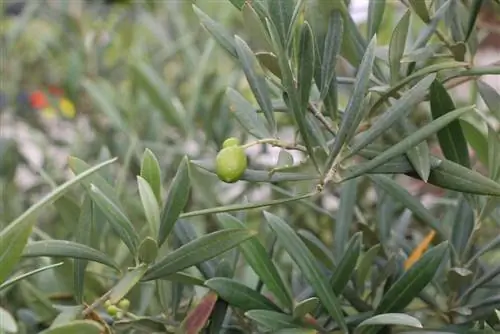
After about 10 days you can move the olive tree to its final location in full sun. The wood then stays outside until the first frosts. Before returning to the apartment in the fall, this process must be carried out in reverse order. Slowly move the pot to a slightly shadier location. Within 10 days the plant will be ready to adapt to the reduced light conditions in the house.
Repotting
If your olive tree is in a plastic pot when you buy it, turn it over and gently pull on the lower end of the trunk to release the root ball. The old pot is often already heavily rooted, which is why it is almost always necessary to repot the tree for the first time immediately after purchase. Young plants should be checked at least twice a year to see whether there is still enough space for the roots in the planter. For older olive trees, it is sufficient to check them before the new growing season in spring (from March).
- preferably use terracotta (clay) pots
- must include drainage holes
- use next larger pot size
- Use tall rather than wide containers (root grows deeper)
- Pull the roots apart a little with your hands and loosen them up
- first fill in a layer of drainage (clay, grit)
- fill in suitable substrate
- Insert bale
- fill with high-quality substrate
Make sure that the tree is not deeper in the ground than before and leave at least two centimeters of space between the ground and the edge of the pot. This means you still have room to water without the water overflowing. The pot should be placed on a suitable saucer that catches excess water well.
Tip:
Bulky clay pots may look very decorative, but they prove to be very impractical for the long-term cultivation of an olive tree. Once the pot is well rooted, the ball can only be removed if you completely destroy the container.
Repotting adult trees
If the largest possible pot size has already been reached, the tree should under no circumstances simply be left to its own devices. In this case, the roots will eventually fill the entire plant pot and displace all the soil. The tree inevitably begins to show signs of deficiency and eventually withers away. To prevent this, the plant should be removed from the plant pot every two years at the latest.
- cut off about 1 to 2 cm of the root network around the ball with a knife
- both on the side and below
- fluff the remaining bale with your hand
- Clean the planter thoroughly
- Fill drainage
- fill in a little fresh substrate
- Insert bale
- Fill gaps with substrate
- water lightly
Removing parts of the root mass creates an imbalance between water supply and evaporation via the leaves. So that there are no shortages in the supply of the olive tree, the crown of the tree should also be carefully trimmed to the same extent as with the roots. After repotting, place the plant in a slightly shady place than before and check the humidity of the ball very carefully to prevent a lack of water.
Flowers and fruits
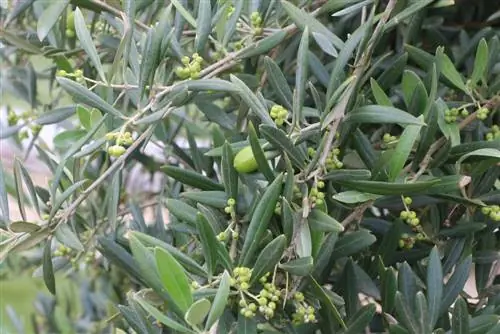
It is very unlikely that an olive tree that has been overwintered warm will produce flowers or fruit. To stimulate flowering (between May and June), the plant requires a drop in temperature to below 10 degrees Celsius over a period of at least two months. If you have the opportunity to place your tree in a cool greenhouse or an unheated winter garden, this could be very beneficial for flower production. Although some olives are self-fertile, if you cultivate a second tree you will get a larger harvest because of cross-pollination. Self-fertile varieties include:
- ‘Aglandou’
- ‘Cailletier’
- ‘Frantoio’
- ‘Leccino’
Planting an olive tree in the garden
Planting an olive tree in your own garden is also possible in Germany. However, olive tree owners are often afraid of doing something wrong, because the trees originally come from the Mediterranean region and are considered very sensitive. However, if you live in a mild region of Germany and follow a few care tips, you can still plant such a tree directly in your garden. When purchasing, be sure to purchase a variety that is slightly more frost tolerant.
- preferably choose a young plant
- cultivate this as a container plant for the first five to seven years
- take them to winter quarters as late as possible in the fall
- Always stay cool and bright over the winter (just above 0 degrees), this helps you get used to it
- Suitable varieties: 'Hojiblanca', 'Manzanilla' or 'Picual'
- The tree has a hard time getting used to it
- Planting hole: at least twice the ball size
- Planting distance: at least 5 m
Make sure that the olive tree has plenty of space. A distance of five meters from the next larger tree is a minimum for normal-sized olive tree species. The same applies to the understory: It is better to avoid other plants in the root area of the tree so that the roots do not grow into each other.
Tip:
Instead of a young plant, you can of course also buy an older olive that was cultivated in a tree nursery in Germany. However, these plants are usually very expensive. It is not advisable to import goods from southern Europe as they are not used to cool temperatures.
Floor
So that the olive tree can grow well and strongly outdoors, it is important to have soil that is well permeable to water, because the Mediterranean plant cannot tolerate waterlogging at all. In addition, the soil must not offer the fine roots much resistance, so that they can spread without too much effort. The tree also prefers a low humus content.
- well drained
- easy
- profound
- only slightly humus
Care
Caring for an olive tree is not particularly difficult. The right location and a good substrate are much more important. If both conditions are optimal, the tree needs little attention in order to grow he althy and strong.
Pouring
Watering is the most important factor when caring for the olive tree. The tree needs a lot of water, especially in summer in a sunny spot. It is best to completely moisten the bale until the water runs out of the drainage hole again. Excess water is poured away. Then wait until the substrate has dried a little before watering the next time. While well-established, planted outdoor specimens tolerate longer periods of drought and high heat, potted plants need to be watered a little more frequently - this is especially true for freshly repotted/planted olive trees and also young plants. Olive trees grow very slowly, so avoid excessive watering - especially in autumn and winter.
The roots of woody plants, which can spread without restriction, reach deep into the garden soil, which is often moister than layers close to the ground. Nevertheless, the trees require balanced watering. When planting specimens, make sure that the water does not simply run off the surface. This can be done either by very slow (fine or drip) watering. Alternatively, a watering edge can keep the water in the root area.
Fertilize
Since there are no special fertilizers for olive trees, you can use ordinary fertilizers for Mediterranean plants or potted plants. Normally, slow-release fertilizers are advisable in March and June. Olive trees do not require high amounts of nutrients, so outdoor plants can usually get by with a little compost in spring.
Cutting
The real olive tree grows very slowly, so it doesn't need to be cut very often. When caring for the tree, pruning only has the function of training and maintaining the tree. Training is about achieving a beautiful crown shape, while maintenance only involves removing diseased and dead branches. If an olive tree becomes too large, you can make smaller cuts all year round. For more radical pruning, spring is recommended, i.e. at the end of the dormant period. This means the plant can sprout freshly in the new growth period.
- cut all dead or diseased shoots
- remove one of two crossing shoots
- cut branches growing inwards at the base
- shorten long, unbranched branches
- Thinning the crown regularly by around 10%
If the crown becomes too dense over time, the tree will become bald from below and within. In addition, the air in the dense crown has difficulty circulating, making the tree susceptible to various diseases.
Overwintering potted plants
If the first frosts occur outdoors, the olive tree must be moved to a protected, warmer location. Here too, make sure you slowly get used to the changed lighting conditions. Choose a spot for your olive tree in the house or apartment that has a southern exposure and provides at least 6 hours of sun per day. Olive trees do not lose their leaves in autumn, so they need a lot of sunlight even in the cold season. To ensure flower formation and to prevent pest infestation, the tree should preferably be kept cool.
- set up very brightly
- optimal temperature: 5-10 degrees
- At higher temperatures an additional plant light is necessary
- continue to water, but a little more cautiously than in summer
- the lower the temperature, the less watering needs to be done
Overwintering outdoor plants
In Central Europe, overwintering planted olive trees is a little more complicated than in their homeland. The first frost damage can be expected from sustained temperatures of -5 degrees. This means that the tree can only be cultivated as a container plant in cold regions. Although planting is possible in wine-growing regions, great importance is attached to good winter protection.
- Hill the soil in the root area well with mulch, leaves or brushwood
- In case of severe frosts, attach winter protection fleece (crown area)
- must be translucent
- may only be used during persistent frost periods
- then remove again
- otherwise the moisture cannot evaporate and illnesses occur
Propagate
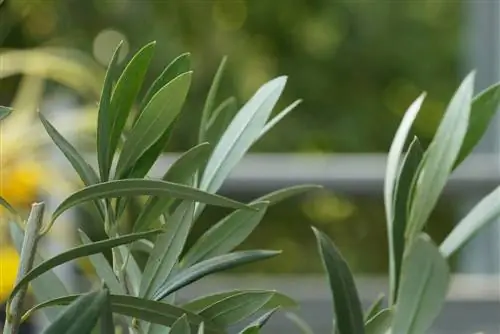
Although olive trees can be propagated from seeds or cuttings, propagation from cuttings is more promising. However, this requires a lot of heat.
Cuttings
Select one or more young, not yet woody shoot tips.
- Length: 10 cm
- Cut edge should be slanted
- remove the lower leaves
- fill small plant pot with cactus or growing soil and moisten
- Insert cuttings one third in
- Press the soil lightly all around
- place in a bright, warm location (without midday sun)
- keep moist but not wet
- Temperature: 20-25 degrees
Tip:
You can tell that the cutting has already formed roots because it begins to form new leaves. In the following two years, the young plant needs slightly higher amounts of water than older plants.
Seeds
Propagation via seeds is a little more complicated, but by no means impossible. To do this, use the seeds from fresh, ripe fruits or alternatively seeds from specialist retailers.
- Remove pulp
- Soak the kernel in lukewarm water for 24 hours
- plant in moist cactus soil
- Planting depth: 1 cm
- Place pot in freezer bag and close
- Temperature: at least 20 degrees
Tip:
It takes a few weeks, sometimes months, for the kernel to germinate. So be patient and don't give up.
Diseases and pests
Like any plant, an olive can be attacked by fungi, viruses, bacteria and various other pests. This is usually the case when the tree is severely weakened. This can happen if the location or care is not optimal.
Waterlogging
When watering amounts are too high (waterlogging), root rot occurs. If the leaves of the tree change color and eventually fall off, this could be a possible consequence of waterlogging. Therefore, ensure a good water balance and fill the pot with a thick drainage layer before potting the plant. In the event of illness, the only solution is to immediately remove rotten soil and roots.
Water shortage
A similar damage pattern to that of waterlogging occurs when there is a lack of water. It must be clarified in each individual case whether the substrate is too moist or too wet.
Tip:
Don't throw away your dry olive tree straight away! Instead, prune the plant vigorously and continue to water it regularly. After a cool and bright winter, the tree often sprouts again in spring.
Conclusion
There are various ways to cultivate an olive tree here. In most cases, planting in pots is advisable due to the lack of winter hardiness. The tree can only be planted in mild wine-growing regions. The following applies to the location: sun, sun, sun. The brighter and warmer, the better. Do not water the olive too often and it is best to ensure that it stays cool and bright over the winter. If cared for properly, an olive tree can grow very old.

